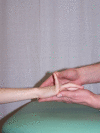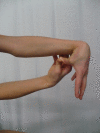Joint hypermobility in children with idiopathic scoliosis: SOSORT award 2011 winner
- PMID: 21981906
- PMCID: PMC3204294
- DOI: 10.1186/1748-7161-6-22
Joint hypermobility in children with idiopathic scoliosis: SOSORT award 2011 winner
Abstract
Background: Generalized joint hypermobility (JHM) refers to increased joint mobility with simultaneous absence of any other systemic disease. JHM involves proprioception impairment, increased frequency of pain within joints and tendency to injure soft tissues while performing physical activities. Children with idiopathic scoliosis (IS) often undergo intensive physiotherapy requiring good physical capacities. Further, some physiotherapy methods apply techniques that increase joint mobility and thus may be contraindicated.The aim of this paper was to assess JHM prevalence in children with idiopathic scoliosis and to analyze the relationship between JHM prevalence and the clinical and radiological parameters of scoliosis. The methods of assessment of generalized joint hypermobility were also described.
Materials and methods: This case-control study included 70 subjects with IS, aged 9-18 years (mean 13.2 ± 2.2), Cobb angle range 10°-53° (mean 24.3 ± 11.7), 34 presenting single curve thoracic scoliosis and 36 double curve thoracic and lumbar scoliosis. The control group included 58 children and adolescents aged 9-18 years (mean 12.6 ± 2.1) selected at random. The presence of JHM was determined using Beighton scale complemented with the questionnaire by Hakim and Grahame. The relationship between JHM and the following variables was evaluated: curve severity, axial rotation of the apical vertebra, number of curvatures (single versus double), number of vertebrae within the curvature (long versus short curves), treatment type (physiotherapy versus bracing) and age.Statistical analysis was performed with Statistica 8.1 (StatSoft, USA). The Kolmogorov-Smirnov test, U Mann-Whitney test, Chi2 test, Pearson and Spermann correlation rank were conducted. The value p = 0.05 was adopted as the level of significance.
Results: JHM was diagnosed in more than half of the subjects with idiopathic scoliosis (51.4%), whilst in the control group it was diagnosed in only 19% of cases (p = 0.00015). A significantly higher JHM prevalence was observed in both girls (p = 0.0054) and boys (p = 0.017) with IS in comparison with the corresponding controls. No significant relation was found between JHM prevalence and scoliosis angular value (p = 0.35), apical vertebra rotation (p = 0.86), the number of vertebrae within curvature (p = 0.8), the type of applied treatment (p = 0.55) and the age of subjects (p = 0.79). JHM prevalence was found to be higher in children with single curve scoliosis than in children with double curve scoliosis (p = 0.03).
Conclusions: JHM occurs more frequently in children with IS than in healthy sex and age matched controls. No relation of JHM with radiological parameters, treatment type and age was found. Systematically searched in IS children, JHM should be taken into account when physiotherapy is planned.
Figures












References
-
- Sherry DD, Malleson P. In: Textbook of Pediatric Rheumatology. Cassidy JJT, Petty RE, editor. Philadelphia: Saunders Comp; 2001. Nonrheumatic Musculoskeletal Pain; pp. 362–363.
LinkOut - more resources
Full Text Sources

